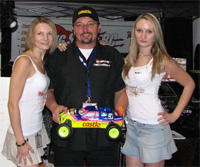RC Racing 101 #3- What Car/Class?

RC Racing 101 #3- What Car/Class? by Tim Mohr
In the first two editions of RC Racing 101 (see here and here) I wrote about how to find a track and what questions to ask once you found one. If you are new to the hobby or a basher just wanting to give racing a whirl the next issue you might have on the way to your first race is what car/buggy/truck to race with. Some tracks have lots of classes and are very accommodating to cars that they do not currently have a class for, but other tracks may offer very few classes and will not let you run a car that doesn’t perfectly fit in. Here’s a top 4 list to help you determine the best class/car for you to race with.
4. The Car You Already Own- This might be the only option for some people, and if you are just wanting to get your feet wet there is no sense in buying a new car just for a race or two. Call ahead to see if the track has a class for your car, if not, most tracks have a “5 cars make a class” rule, so you might be able to ask around and have other people help fill up the class. If your closest track does not offer your class, then check other tracks in your area, you might get lucky. If it’s going to be a long drive each week to race the car you own, it just might be cheaper to just buy a new one.
3. Easy To Drive- Some cars/classes are easier to drive than others. Typically the smaller the scale the harder they are to drive, and 2wd is nearly always harder to drive than 4wd. Among some of the hardest to drive classes are 12th scale on-road, 18th scale off-road, and 2wd 10th scale buggy. Considered some of the easiest classes to drive are 8th scale truggy, and touring car, but of course this varies by track and with personal driving styles.
2. Price- If you are up for buying new just for racing, some cars naturally cost more than others, and not just in brand names, but also in operational costs. Typically the larger the scale the more they will cost you to run a season, with 8th scale on and off road considered to be two of the most expensive. But remember, the cost of racing is totally up to you. For example, you can easily sink over a thousand bucks into a little 18th scale car, or you can race it bone stock for just over $200. You can race a spec short course truck for under $300 and spend very little on a weekly basis for tires and other support equipment, or you can bling out one of the 4×4 short course racers and spend over a grand right off the bat. I must also mention that rarely does the amount of money spent equal more fun, as more expensive usually only equals faster cars. In fact, many racers will often tell you the most fun they ever had was in the cheapest class they ever ran.
1. What’s Popular- Every track will have one class that is more popular than any other. Racing in the largest class has several advantages like typically having more people of a similar skill level to your own, more people to get set-up advice from and more spare parts to borrow from fellow racers. At some tracks the “popular” class changes on a yearly, sometimes even monthly basis, while at other tracks it has remained the same for over a decade. So at some tracks if you buy what’s popular this season it might be good for several years, while at others you might be buying a new car every couple months, it just varies with the track.
Until next week, see you on the grid.

